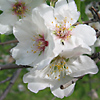Common Almond is a winter-deciduous tree that reaches a height of 3-8 meters. The leaves are elongated, simple, with dentate margins. They are 1-5 cm long. The leaf arrangement on the stem is alternate. In winter the leaves are shed. The flower buds are arranged in groups on the exposed stems, gradually open and color the tree in pink or white. The blooming time and its uniformity are directed by the cold dose which the tree absorbed since it began shedding its leaves.
The almond tree blooms early. It blooms before it sprouts and is absolutely beautiful when it blooms in Maquis and in abandoned almond groves on terraces on the mountains. The flowers are bi-sexual and arranged in groups. The corolla of the flower is separated (choripetalae). It has 5 petals and 5 sepals. There are 10-30 separated stamens that are connected at their base to the calyx tube. The flowers are fragrant and attract bees. The ovary is superior and contains one carpel. The fruit is a drupe with a length of 3 cm enveloped by a green and pilose shell (pericarp) which with time changes to brown. When the fruit ripens the shell splits in two and usually falls. The almond seed in an additional brown and hard shell that splits only under pressure remains on the tree. Another shell envelops the cotyledons. This shell is thin and brown. The edible part is the seed. However, the fruits of the almond are also eaten in their entirety when they are still green. The seeds have great nutritional value and contain fat, protein and calcium, among others.
The bitter almond plant serves as a root stock on which domesticated almonds are grafted .. Seeds of bitter almond should therefore not be eaten. They contain a substance called amygdalin. When eaten the poison cyanide is released from the amygdalin. This is a mechanism that protects the seeds from being eaten by animals. It is found not only in almonds but also in other plants such as the leaves of one of the lotus species that grow in Europe and in the thickened roots of the Cassava (Manihot esculenta) plant, which is an important agricultural product in South America and Africa.
The tree is common in Maquis in the entire Mediterranean region, from the north of Israel to the south, in limestone soil, as well as in Mediterranean regions with low precipitation. Remains of abandoned almond groves are found on the mountains.
Almond groves of improved varieties have been planted in several regions in Israel, for example near Kfar Tavor.
The sweet almond is also valuable as a medicinal substance. Almonds neutralize the stomach acids, serve as a cough medicine, reduce phlegm, are beneficial against headaches, depression, etc. The medicine is produced by grinding the seeds and extracting the oil from them, or eating ground seeds. It can be mixed with milk, lemon juice or honey.
The tree blooms from January until March. It has an East Mediterranean and West Irano-Turanian distribution. The tree is protected by law.
Written by Erga Aloni









